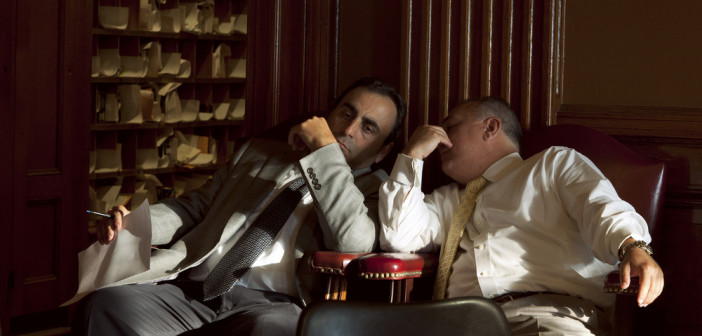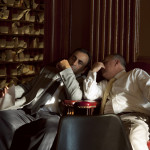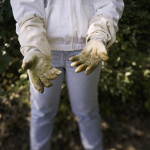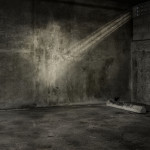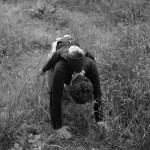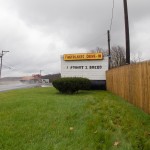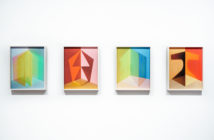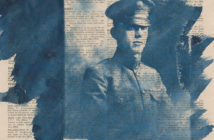 Victoria Crayhon (Providence, RI), Untitled, Auburn, NY, 2010, from the series "Thoughts On Romance From the Road," Archival inkjet print, 24 x 36 inches, courtesy of the artist
Victoria Crayhon (Providence, RI), Untitled, Auburn, NY, 2010, from the series "Thoughts On Romance From the Road," Archival inkjet print, 24 x 36 inches, courtesy of the artistWe’re used to a certain type of photography in the New England art scene, and if you have the eye for it, then Cultivated, the recent group exhibition of "New Photography from New England," would have delivered to your highest expectations. Featuring ten artists at the beginning of their professional careers, some greener than others, the show was woven together, somewhat loosely, by the shared thread of human relationships, those with the land, with each other and family, and, finally, with that unanswerable but ever nagging question of identity: Where did we come from? What are we? And where are we going? To be sure, there were outliers in the bunch, artists whose work diverges from the landscape and portrait genre that paves a long road through the history of photography into paths of new conceptual endeavors less frequently traveled. I confess that this is my own bias, but as the Cultivated exhibition heralded the "new," I’d like to start there.
As part of the Flash Forward Festival, the New England photographers’ exhibition ran for four days only at the Fairmont Battery Wharf Hotel. The May 17 opening was well attended; students and professors from local art schools, curators, artists, and art enthusiasts of every stripe packed the gallery on Friday evening, sipping wine and discussing the day’s events. The exposure for participating photographers was tremendous, despite the short run of the show. Among those photographers were Victoria Crayhon and Alexander Harding.
Taking visual cues from Jim Dow and Stephen Shore, Crayhon photographs marquees and billboards, unusual and uncanny texts along stretches of roads in otherwise ordinary places. My eye was immediately caught by her color palette, seemingly more vibrant than that of her peers, but with a decidedly 1970s veneer, and by her obvious good humor. In one photograph, a sign sandwiched between a wooden fence and a country road reads "I FORGOT 2 BREED." It’s the marquee for "Fingerlakes Drive-In." Just up the road, we see an enormous runner in the distance, heading our way and straight into a truck hauling lumber. It’s another billboard, a placement that could not have been more accidental or more perfect.
Crayhon’s "Castle" movie theater, already steeped in a kind of nominal irony, advertises the upcoming show: "Loosely Premeditated Action Sequences." The text, as much as the photograph, is her own work, an artistic intervention she leaves behind. Like graffiti, her words have personal meaning, with just a dash of transgressive appeal, but are broadcast in public places. These textual interventions take her photographs beyond traditional street photography, while paying all due respect to its history of incorporating signage as a compositional and semantic element.
 Alexander Harding (Wallingford, CT), 3:42 p.m., 2010, from the series "Visible Light," Archival inkjet print, 24 x 30 inches, courtesy of the artist and Panopticon Gallery
Alexander Harding (Wallingford, CT), 3:42 p.m., 2010, from the series "Visible Light," Archival inkjet print, 24 x 30 inches, courtesy of the artist and Panopticon GalleryRemixing another fundamental and well-known relationship, Alexander Harding writes his images not only with light, but about it. You might say he creates light in the form of photographs, taking it as his subject matter as much as his means of production. The resulting abstractions are walls, mirrors, and windows, not mere formalist objects of unidentifiable origins, in that most familiar of places, the home. In each, Harding notes the exact time of exposure, turning recordings of light that parallel scientific measurements into works of art. I am not quite sure where this investigation will lead him, or if a sustained inquiry into photographing light itself can develop in unexpected ways, but there is something in the transformation of recordings into evocative aesthetic objects that holds my attention.
I like, too, that I am less sure of Harding’s location in the environment or his place in the exhibition, which leans heavily on the idea of groundedness in community and nature, cultivation of land and relationships, and natural and human growth. In a similar way, S. Billie Mandle creates abstractions out of parking garages, turning drab concrete into minimal and sparse compositions that strike the eye. I am not certain that I agree with the artist that those spaces transform into something other than parking garages, or that they become strange or purposeless with the intentional removal of their lines and directional language. But the photographs, like much of her previous work, are beautiful, and that in itself is somewhat extraordinary considering her subject matter.
Still other artists traverse more well-worn territory, but take unexpected turns. Cole Caswell prints large landscapes in a New Topographics vein, but does so on newsprint using wet-plate collodion negatives. The intended effect, that of a confusion of time, is elusive, as the deserted places he photographs, a veritable no person’s land, are indelibly marked by structures and industry that are historically identifiable. I am left wondering why he chose wet plates after all. The marks of the process do indeed stain his prints, as Caswell notes in his artist’s statement, and with some imagination those stains parallel the abandoned debris they capture. But the connection is tenuous.
 Scott Alario (Providence, RI), Floating, 2012, from the series "What We Conjure," Archival inkjet print, 20 x 25 inches, courtesy of the artist
Scott Alario (Providence, RI), Floating, 2012, from the series "What We Conjure," Archival inkjet print, 20 x 25 inches, courtesy of the artistBy contrast, Scott Alario uses an 8 x 10 camera to plumb the depths of familial and natural connections. Surreal portraits of his daughter and wife swathed in the universe, beneath constellation or mobile, are coupled with photographs of himself providing a makeshift tent out of his body and a bed sheet for his daughter. There is a sense of play and magical delight in the natural world that permeates his images.
Also in the Cultivated exhibition are Christine Collins, Amy Montali, Andrew Fillmore, Nelson Chan, and Tony Luong. Collins’ photographs are from her series of bee keepers. Ostensibly about our bond with the land, I could not help but notice that the bee keepers in her photographs wear protective gear from head to toe to shield themselves from the immediate environment they have built around them. Montali’s work is a kind of "momentary" portraiture, while Fillmore straddles the line between fiction and reality in his series of documentary photographs, some staged, of behind-the-scenes politics. Chan and Luong focus on questions of identity and liminality between cultures in their family photographs, but take a literal approach to convey the sense of leaving, longing, and impermanence that relies too heavily on images of planes, packed suitcases, and clear-cut travel photography.
Boston sometimes gets a bad rap for being a conservative, restrained art world, but new work from innovative New England artists who have roots in the city could change that. To my eye, that potential was not fully realized in Cultivated, with its double entendre on landscape development, the natural growth within the photographs, and the rigors of education in the area, the stylistic growth of the artists under a particular pedagogy. But for art aficionados who prefer the traditional style, and they’re entitled to their tastes, after all, the clean and formal look of the exhibition had much visual charm to proffer, much like a well-manicured English garden.
- Andrew Fillmore (Providence, RI, and New York, NY), House Chambers, 2012, from the series “Politics as Usual,” Archival inkjet print, 22 x 30 inches, courtesy of the artist
- Christine Collins (Boston, MA), Untitled, 2010, from the series “The Keepers,” Archival inkjet print, 24 x 30 inches, courtesy of Jen Bekman Gallery and the artist
- Nelson Chan (New York, NY / Portland, ME), Morning Coffee, Hong Kong, 2007, Archival pigment print, from the ongoing series “my Da Lu,” courtesy of the artist
- Alexander Harding (Wallingford, CT), 3:42 p.m., 2010, from the series “Visible Light,” Archival inkjet print, 24 x 30 inches, courtesy of the artist and Panopticon Gallery
- S. Billie Mandle (Amherst, MA), San Mateo 3, 2010, from the series “San Mateo,” Pigment print, 30 x 40 inches, courtesy of the artist
- Scott Alario (Providence, RI), Floating, 2012, from the series “What We Conjure,” Archival inkjet print, 20 x 25 inches, courtesy of the artist
- Victoria Crayhon (Providence, RI), Untitled, Auburn, NY, 2010, from the series “Thoughts On Romance From the Road,” Archival inkjet print, 24 x 36 inches, courtesy of the artist
Cultivated was curated by Leslie K. Brown, independent curator and educator, and Michelle Lamunière, John R. and Barbara Robinson Family Assistant Curator of Photography at the Harvard Art Museums.

